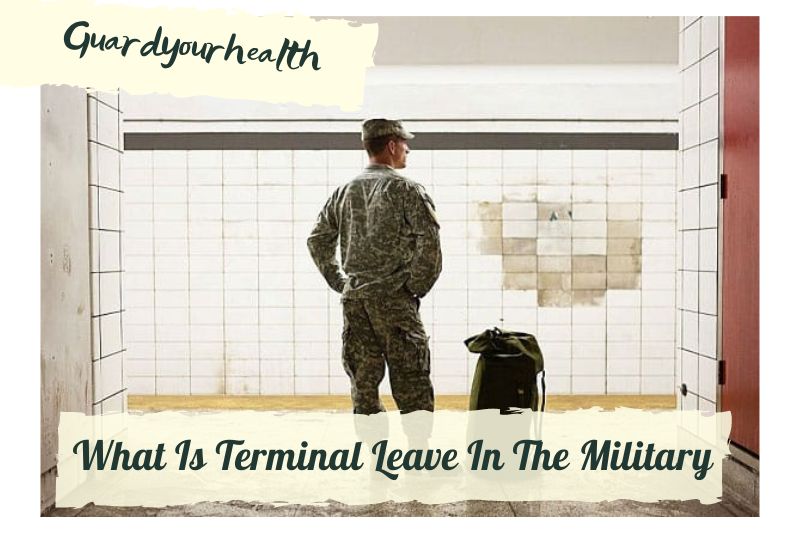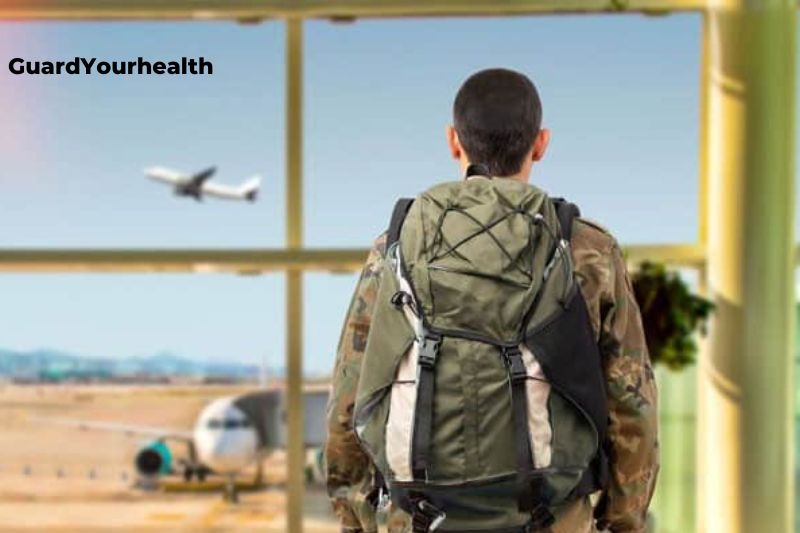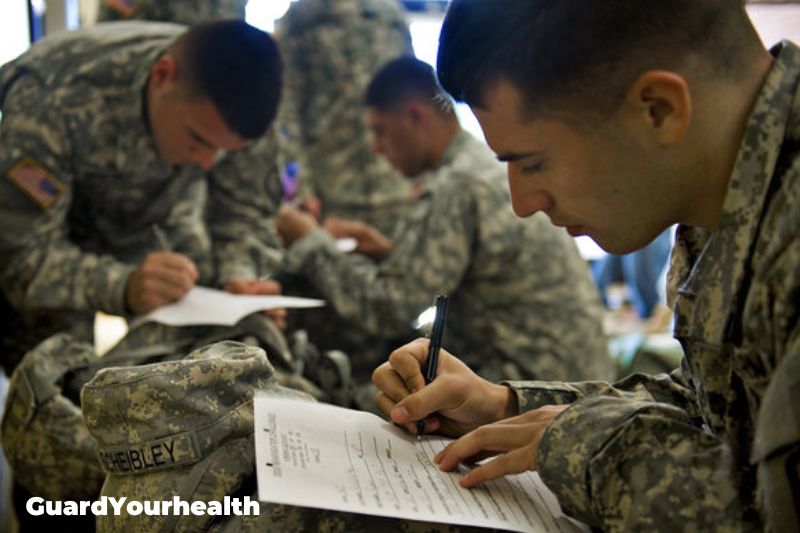ArmyTerminal leave is the period of time between a service member’s discharge from active duty and the date on which they are required to report to their next duty station. This leave allows service members to transition back to civilian life and to take care of any personal or family business before reporting to their next assignment.
In this blog, Guardyourhealth will explore What is terminal leave in The Military, how it works, and how to make the most of it.
What is Terminal Leave?
Terminal leave, also known as transitional leave, is the last leave provided to an armed forces member right before discharge, equal to the total unused leave accrued during active service.
You are officially discharged from the military.
You can anticipate finishing your administrative out-processing and then turn in your gear and military ID, just like anyone else leaving the service.
You continue to receive your payment and other benefits while on terminal leave, but you are not obligated to return to your duty station.
Many service members intend to take as much terminal leave as possible in order to ease their transition into civilian life.
During this time, you can hunt for work, arrange a move to a new home or city, and attend to other matters.
Terminal Leave Policies
- Army: AR 600-8-10
- Air Force: Air Force Reg 36-3003 (6 June 2019)
- Marine Corps: Order 1050.3J
- Navy: NAVCOMPT 3065
Types of Military Leave
Ordinary leave, terminal leave, emergency leave, convalescent leave, excess leave, permissible temporary duty (TDY), and block leave are the seven categories of leaves.
We’ll take a closer look at each of them now!
1. Terminal Leave
Personnel can use their accrued remaining leave before retiring or separating from the military. This is also known as accumulated leave or transitional leave. Members use the latter moniker to move back into civilian life.
The military person on terminal leave will not have to complete military responsibilities but will still get a wage and other benefits such as medical coverage, basic housing allowance, and basic subsistence allowance.
It’s similar to paid time off for civilian employees. The leave must be processed prior to the amount of time the member wishes to take. For example, if a member has 30 days of leave remaining and plans to retire on May 30, he or she can begin taking the leave on May 1, but the leave must be allowed prior to that date. You will be required to turn in your military gear and identification as part of the processing.
Active-duty service members, including Reserve and Guard members, accrue two and a half days every month. While there is no “ideal” moment for terminal leave, it is recommended that you take it before your ETS, at home, or while job looking because you can better prepare for life after the military this way.
You can “sell” your days back to the military if you do not wish to take your terminal leave. For everyday cash in, the value is 1/30 of the base. However, keep in mind that this is not yet a tax deduction.
Consider seeing this YouTube video if you are debating whether to take terminal leave or sell back your leave.
2. Ordinary Leave
Ordinary leave is chargeable leave time taken on a regular basis.
3. Emergency Leave
Emergency leave is when a leave request is processed more rapidly due to an emergency. However, it is still considered a chargeable leave.
4. Convalescent Leave
Convalescent leave is non-chargeable leave that is only granted if accompanied by a doctor’s statement and signature stating that the service member must be absent from duty for an extended period of time.
5. Excess Leave
Excess leave, as the name implies, occurs when a member takes more leave than his or her allotted leave period. This type of leave is not billed.
6. Permissive Temporary Duty (TDY)
TDY (permissive temporary duty) is a type of non-chargeable leave. It typically lasts 20 days and is used when a service member travels between locations for official purposes.
A member who takes this form of leave is not charged, but he or she is not eligible for travel compensation. It is usually used for a permanent change of station or while looking for a new location to live.
7. Block Leave
This is when all or most of a military unit goes on leave. Typically, this occurs during holidays and observances such as Christmas. It also occurs during the summer and the following deployment.
Update on COVID-19 Special Leave Accrual
The Department of Defense understands that the COVID-19 national emergency has severely constrained the capacity of military members to take leave. The department also emphasizes the importance of leave for one’s health and well-being. That is why, on April 16, 2020, Under Secretary of Defense for Personnel and Readiness, Matthew Donovan signed a department-wide authority allowing military members to collect and retain up to 120 days of excess leave balance. Members who served on active duty from March 11, 2020, to September 30, 2020, might collect up to 120 days of leave and keep unused time until September 30, 2023.
When Can You Take Leave?
Service members have the right to request leave at any time. The command will make the decision based on a variety of considerations, including operational requirements.
Some commands may specify times when all or parts of the command can exit at the same time. This is known as “block leave,” and it might occur before or after a deployment, as well as during a holiday period. Block leave is commonly granted during the summer and Christmas holidays, as well as before and after deployments.
How to Request Leave
Each command will have its own system for requesting leave. It could include a physical or electronic leave request form, also known as a “leave chit.” The request for leave will then be approved or denied by the command.
The service member must tell the command when they begin their approved leave, also known as “checking out,” and when they return from leave, also known as “checking in.” The policies and procedures for checking out and checking in vary by command and may include physical presence, telephonic or electronic communication, or both.
Military service members receive 30 days of paid leave per year as part of their salary and benefits package. Starting at zero, 2.5 days of leave are added to your leave account for every month of military duty. It doesn’t cease, but the maximum you may carry over from one fiscal year to the next is 60 days unless there are certain, extremely limited circumstances in which you can carry over more.
Reserve component personnel, including National Guard troops, earn 2.5 days of leave for every month they are on active duty. Reserve components are subject to additional rules regarding how and when they can use their leave.
Service personnel is expected to use leave for any workday that they will not be available for work due to a command need. They must also use leave on any day that they leave the neighborhood of their duty station, as defined by their command.
You’ve Earned it – Use Your Leave Or Lose It
Leave time accumulates when it is earned, but there is a limit to how much can be carried over from one fiscal year to the next. If you have more than two months of unused leave, you typically lose any amount that surpasses 60 days at the end of the fiscal year, which is September 30.
Over 60 days of leave may be carried over for a length of time by a service member. This is known as a special leave accrual, and it is frequently approved due to deployment to specific locations throughout the world, assignment to specific specified units, or operational constraints that preclude the service member from taking a vacation.
Selling Back Leave
Service members can sell back leave when they reenlist, prolong their enlistment, or resign from the service. Over the duration of your military service, you may sell back up to 60 days of leave. Military leave is resold at your base pay rate, excluding any extra pay or allowances.
Other Facts to Consider Regarding Military Terminal Leave
Following are a few terminal leave Army policy changes resulting from the COVID pandemic:
Military members can accrue leave days in excess of 60 to 120 from March 11th to September 30th, 2020. This is classified as a special leave accrual and can be used until the end of the fiscal year 2023. However, any vacation taken after September 30, 2020, will be forfeited if not used by October 1, 2021.
Tips to Make the Most Out of Military Terminal Leave
Finding out “What is a terminal leave in the military?” is one thing. Knowing how it pertains to you, on the other hand, is another story. Here is a section providing advice on how to make the most of your vacation time. Here are a few things you should do to make the most of your military terminal leave:
1. Invest in yourself.
The first item on this list is to schedule time for oneself. Life in the military was not easy. It was fraught with danger and stress. So now is the time to move on from it. You can travel, spend time with family, or engage in self-care activities.
Whatever you do, make relaxation and decompression your top priority. This is also quite crucial for a smooth transition from military to civilian life.
2. Protect your housing
Housing is ranked second on this list. You must ensure that you have a place to live when you separate or retire from the military. There are several housing possibilities, so it is critical that you take the time to explore and compare them.
Will you relocate your family? Will you have to look for a house? If it is the latter, keep in mind that finding a home to live in is a time-consuming procedure, and do not leave it until the last minute!
3.Secure a job
When returning to civilian life, this is one of the most challenging duties. As a result, taking advantage of your terminal leave time to get a head start is a wise decision.
Use your free time to apply for jobs, attend job interviews, and/or gain job qualifications such as degrees and certificates. This is essential for a smooth transition back into civilian life. It is a productive way to spend your final days off.
You’ll be glad you used your time wisely, believe me.
FAQs
1. When Is It Best to Take Terminal Leave?
The “ideal” moment to take terminal leave is also the only time – before your ETS, but also if you are looking for a job or a place to live.
Your ETS (expiration term of service) date is written on your contract, and you are allowed to leave the military on that date.
2.How long is army maternity leave?
Six weeks, and it must begin the first full day after the mother’s release from the hospital or birthing center after pregnancy and childbirth. If maternity convalescent leave exceeds 6 weeks, caregiver leave granted to the birthparent is reduced 1 day for each day of maternity convalescent leave exceeding 6 weeks.
3. Tips for Making the Most of Military Service Should I Resell My Termination Leave?
Yes. No. Maybe.
Sorry, but there is no single proper solution to this question. Everything comes down to you.
The essential thing to remember is that you can only sell back up to 60 days of leave during your military service.
When enlisted servicemen leave the military with an honorable discharge, they can sell back their leave. Officers can only sell back leave if they are leaving the service under honorable terms.
So, would you rather utilize your vacation time to search for a new job, find new accommodation, or take a vacation?
Or do you already have some of those things in the works and just want the extra money?
It is up to you whether you have the time or the money.
4. How Do I Work Out How many terminals Leave I Can Get?
Terminal leave is worth one-third of one’s base pay per day cashed in.
Taxes, on the other hand, are taken from your final payment at a rate of 25% for federal tax and variable amounts for state tax!
Although you can still receive BAH or BAS while on terminal leave, those allowances are not included in the terminal leave’s actual value.
5. Where Can I Get Medical Attention While on Terminal Leave?
You still have TRICARE Prime while on terminal leave.
You can seek treatment at any military hospital or clinic, and you will continue to be given first attention.
You can seek routine or urgent care at a Veterans Affairs medical facility if you reside nearby, but you will not be permitted for any non-VA care.
6. How much terminal leave can I take?
60 days
7. Do you accrue leave while on leave?
An employer’s policy governs whether an employee on Family and Medical Leave Act (FMLA) leave continues to accrue paid leave. Often, an employer’s policy states that when an employee is on paid leave, accrual continues, but when an employee is on unpaid status, accrual ceases.
Conclusion
In short, Terminal leave is the military leave that is granted to a service member who is separating from the military. This leave is typically granted for the purposes of transitioning back to civilian life. It can be a difficult adjustment for some, but most find that the support of family and friends helps immensely. For others, the challenge of starting anew is invigorating. No matter what the future holds, all who have served can be proud of their service and the sacrifices they have made.
Thank you for taking the time to read!












